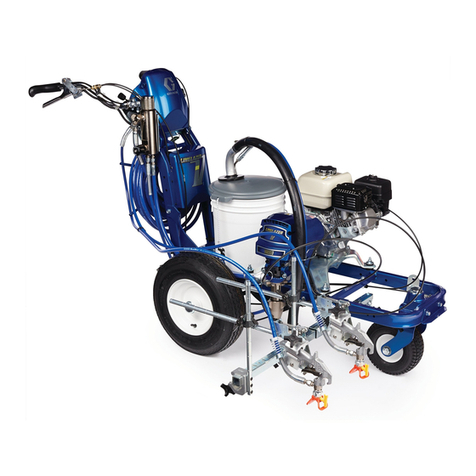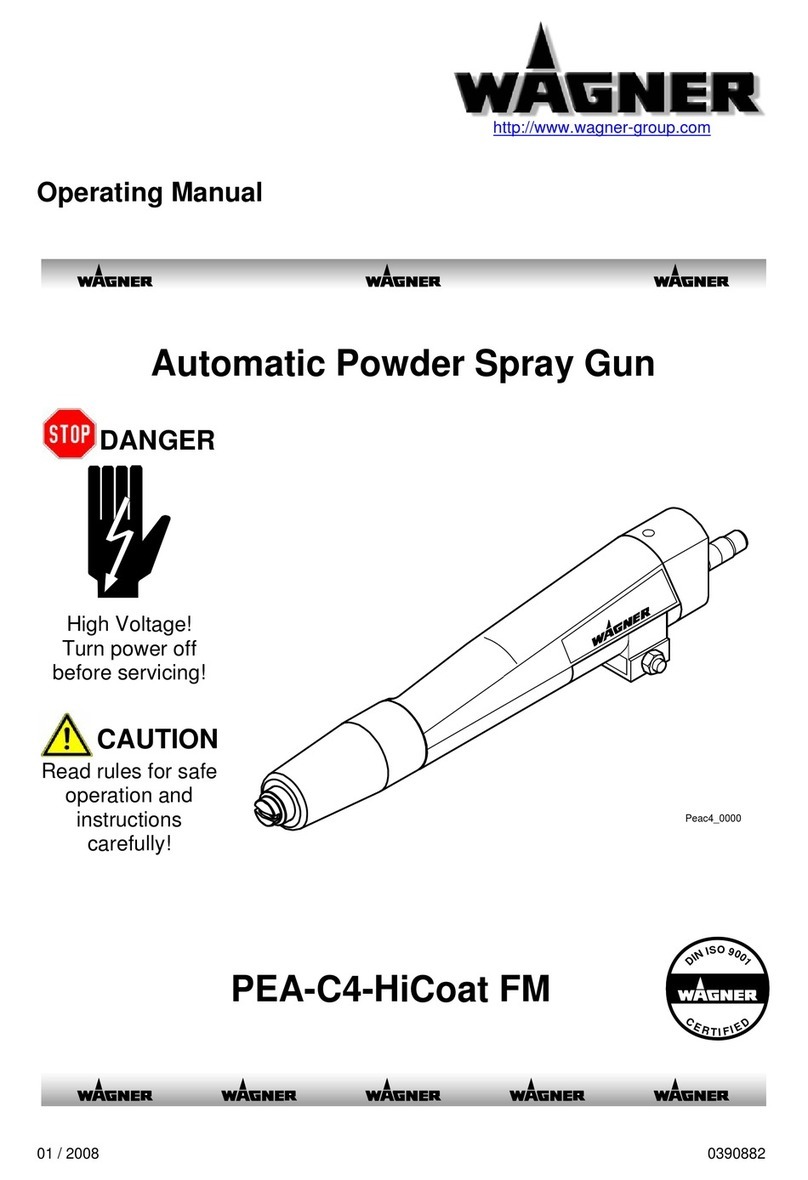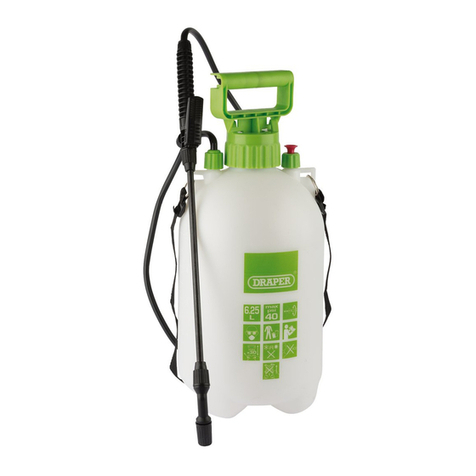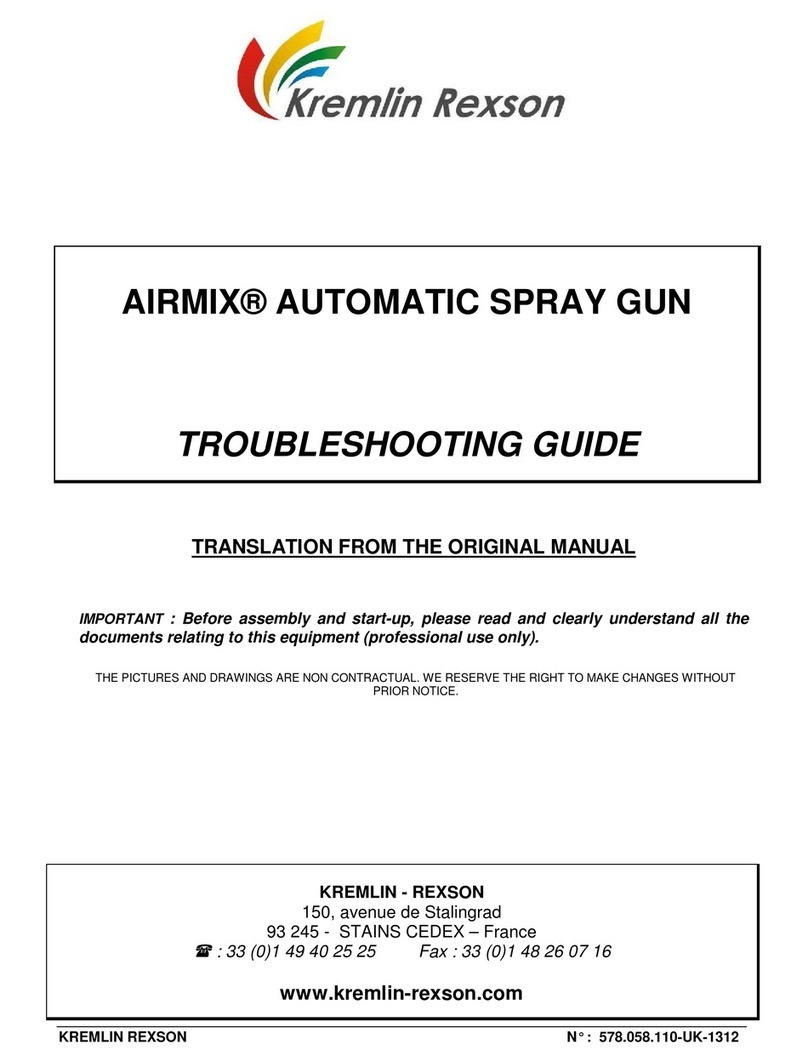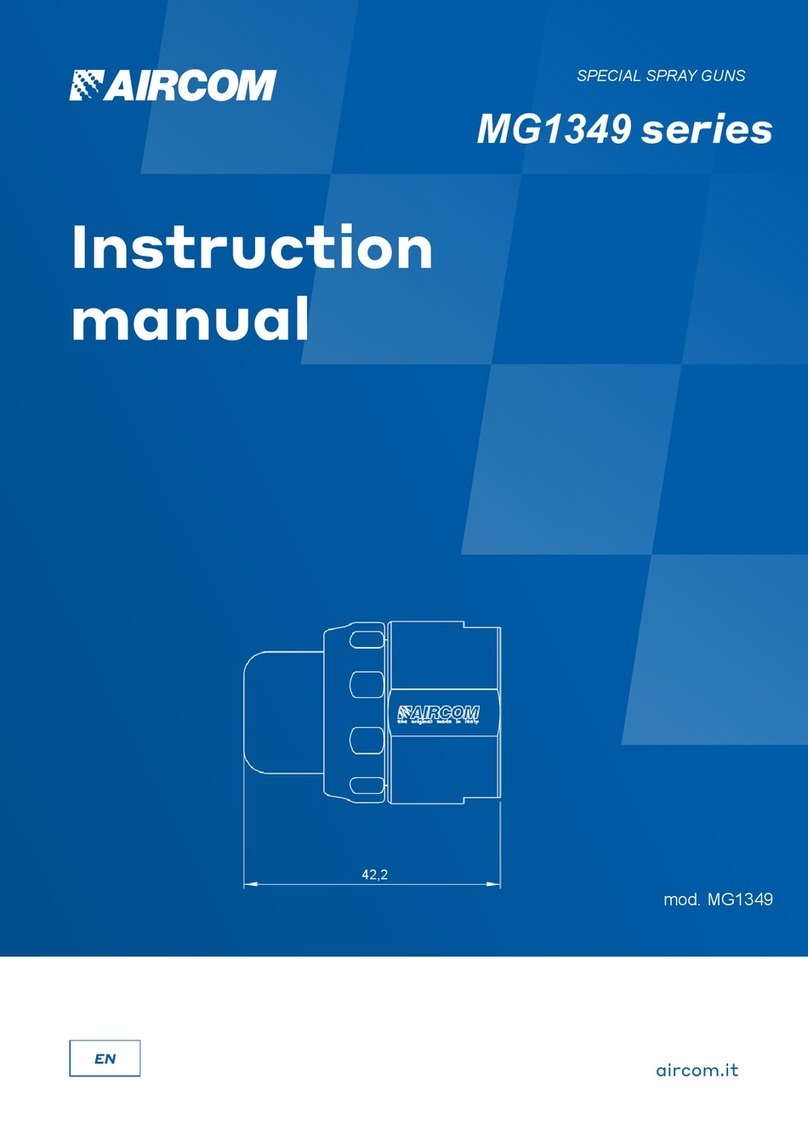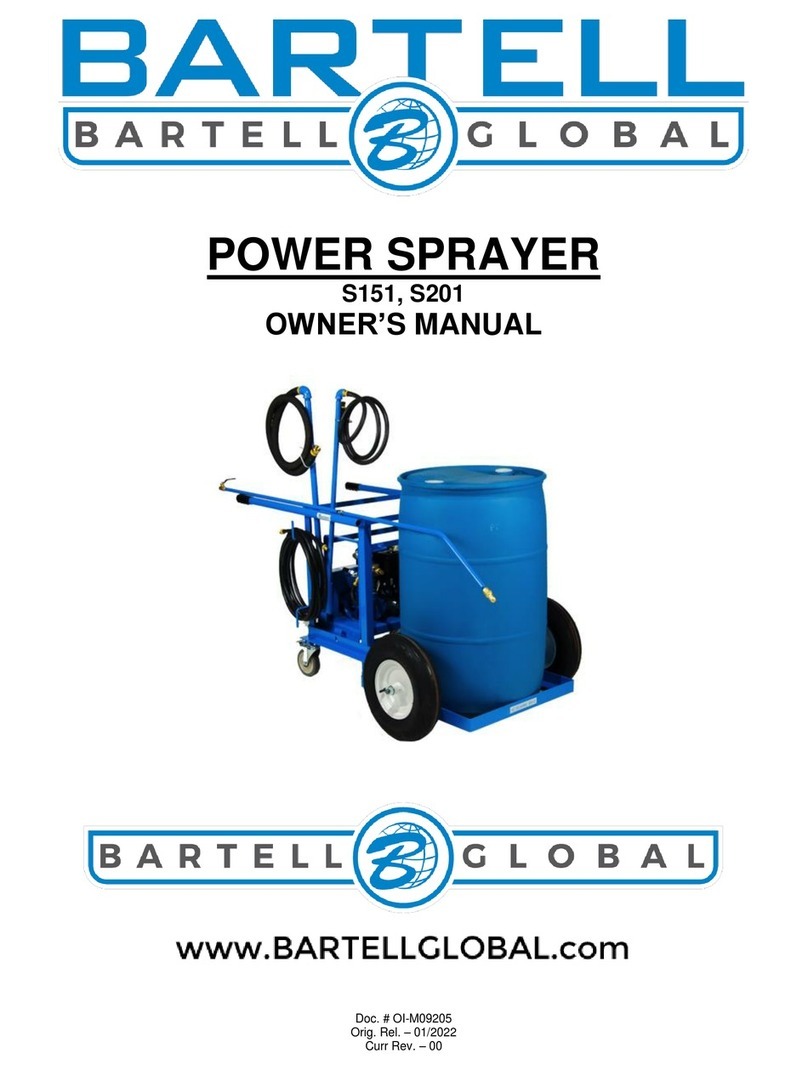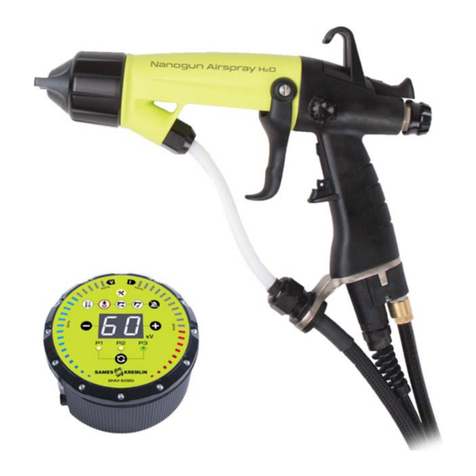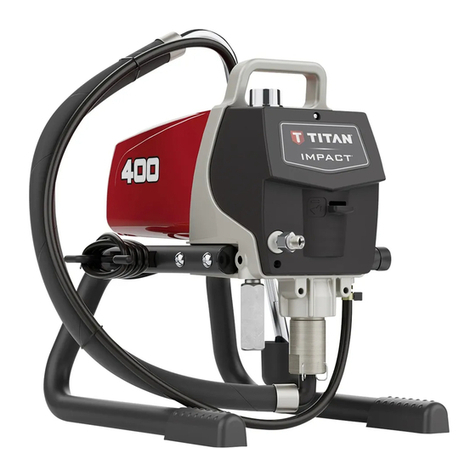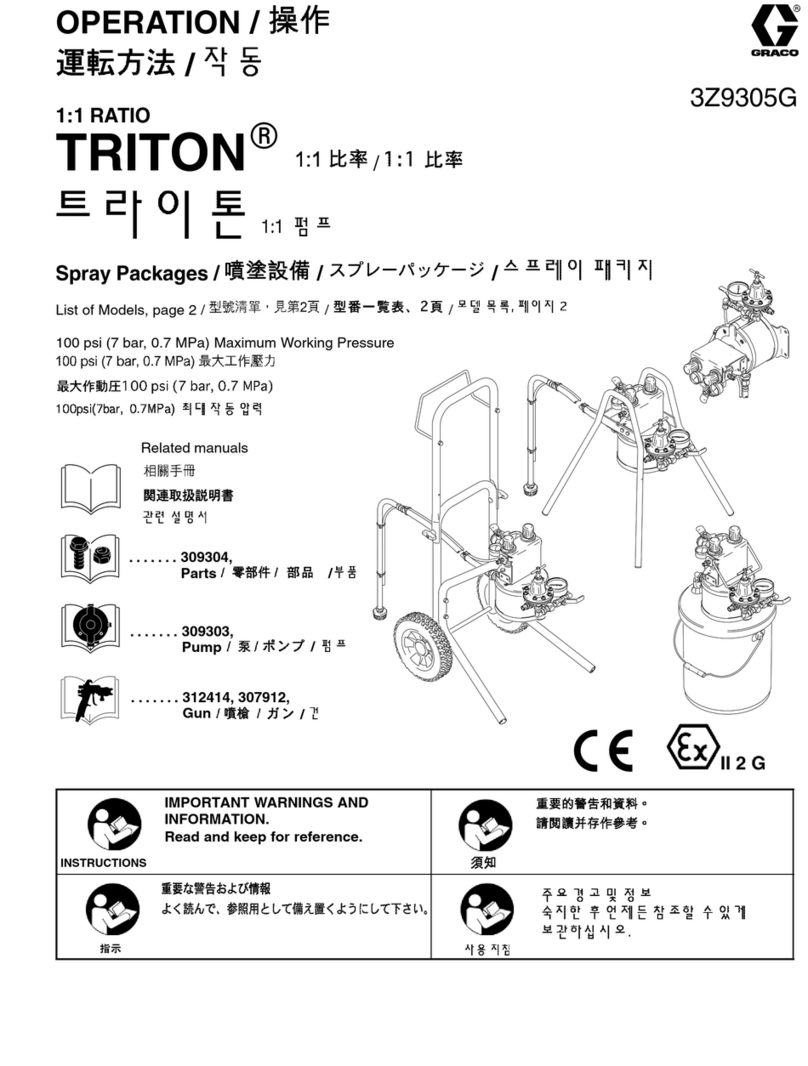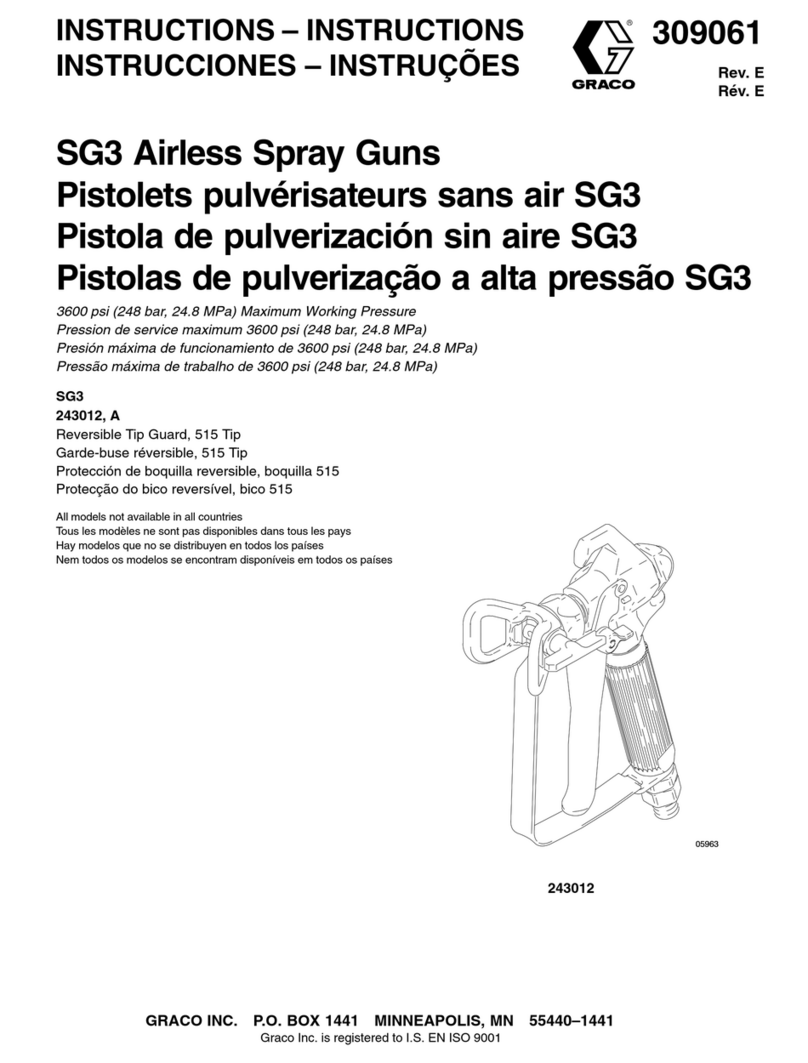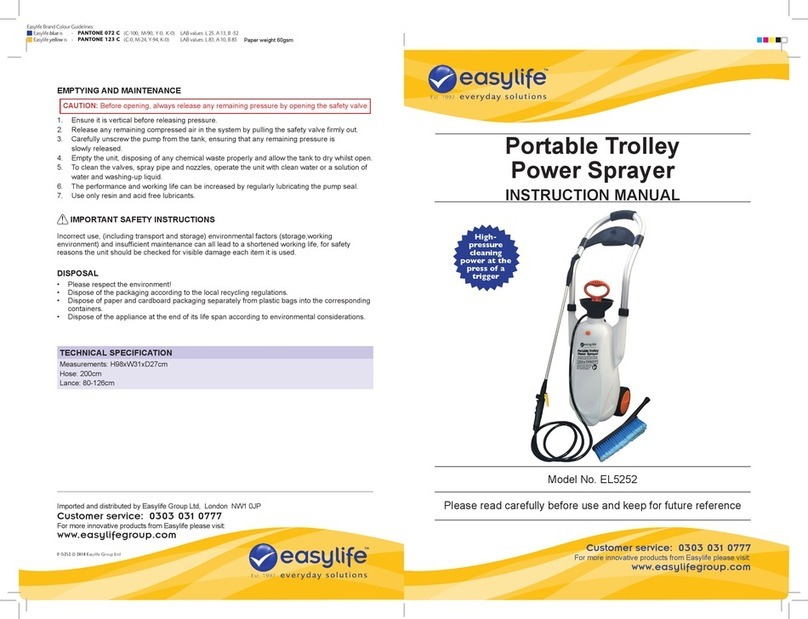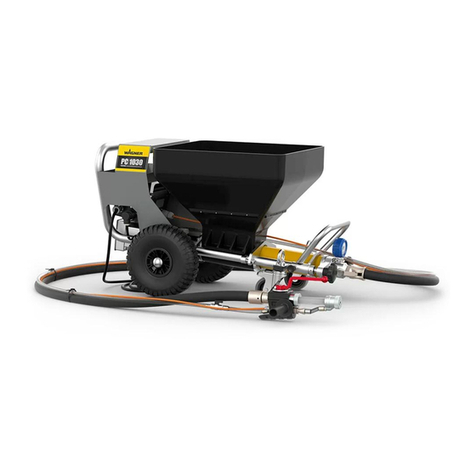Surtek 130401 User manual

4 gal (15,1 l)
130401
Fumigador Profesional tipo Mochila
Professional Backpack Sprayer
ATENCIÓN: Lea, entienda y siga las instrucciones de seguridad contenidas en este
documento, antes de operar esta herramienta.
WARNING: Read, understand and follow the safety rules in this document, before operating this tool.
Manual de Usuario y Garantía
User’s Manual and Warranty

2
ESPAÑOL
ADVERTENCIAS
Cuando se trabaja con equipo a presión, siempre se
deben tomar medidas de seguridad como las siguientes:
• NUNCA fumigue materiales inflamables ni presurice
agentes químicos productores de gas, como el
hidróxido de sodio.
• Lea SIEMPRE la etiqueta de los productos químicos
antes de llenar el fumigador, ya que algunos productos
químicos pueden ser peligrosos al utilizarlos con el
fumigador.
• Cuando utilice el fumigador SIEMPRE utilice anteojos
protectores, guantes, camisa de manga larga y
protección completa en los pies.
SIEMPRE QUE UTILICE EL FUMIGADOR USE GUANTES
DE HULE GRUESO, PROTECCIÓN EN LOS OJOS, ROPA
DE PROTECCIÓN y utilícelo en áreas ventiladas o al
aire libre. Antes de cualquier reparación, limpie el
tanque del fumigador con agua, para hacerlo llene
con agua y pulverice el agua en un área apropiada,
al aire libre o en un contenedor. Asegúrese de que se
libere toda la presión poniendo la válvula de cierre
en la posición abierta. Cuando termine la reparación,
llene el fumigador con agua y presurícelo para
verificar si hay fugas. NO UTILICE EL FUMIGADOR SI
ÉSTE GOTEA. Repare la fuga y vuelva a verificar el
fumigador.
• NUNCA deje el fumigador presurizado bajo el sol ni
en lugares cerca de alguna fuente de
• calor. El calor hace que la presión aumente y puede
causar que el fumigador se incendie
• o explote causando lesiones o muerte.
• NUNCA presurice el fumigador de cualquier otra
manera que no sea con la bomba original. Si el
fumigador se presuriza demasiado puede explotar y
causar lesiones o muerte.
• NO trate de modificar o reparar este producto,
excepto con las partes originales del fabricante.
• REVISIÓN PREVIA AL USO: Revise que la tuerca de la
manguera esté bien apretada para asegurar que la
manguera se encuentre sujeta en forma segura a la
válvula de cierre.
• Asegúrese de que la manguera se encuentre sujeta en
forma segura al tanque, apretando la abrazadera de
la manguera si es necesario. Asegúrese de que todas
las conexiones de la boquilla y la varilla estén bien
apretadas.
NOTA: El tanque y la manguera pueden tener agua
residual en su interior, debido a pruebas de calidad
realizadas en el fumigador.
USO Y APLICACIÓN DE SU
FUMIGADOR
Si es posible, evite el uso del fumigador con fines
de limpieza si éste ya fue utilizado con productos
protectores para plantas o químicos herbicidas. Si el
fumigador ha sido utilizado con productos protectores
para plantas o herbicidas, limpie completamente el
fumigador antes de utilizarlo.
Fertilizante: Utilice diferentes tipos de patrones de
pulverización para la óptima nutrición de follaje o para
la aplicación de fungicidas y pesticidas.
Herbicidas: Reducen la maleza y plantas no deseadas,
evite utilizar el mismo fumigador que usa para fertilizar
o proteger plantas sin primero limpiar el fumigador por
completo (consulte la página 6).
Uso general en el hogar: Aplique detergentes, vinagre,
soluciones limpiadoras, agua tibia (que no exceda los
120°F/49°C) o químicos limpiadores para el hogar no
tóxicos en alfombras, pisos, paredes, vidrio, encimeras
y techos. NO utilice el fumigador que se utilizó con
herbicidas, pesticidas u otros químicos tóxicos para
aplicaciones en el hogar.
Uso general en exteriores: Utilice el fumigador para
limpiar ventanas o para aplicar algún detergente para
propósitos de limpieza general. Otras aplicaciones
incluyen a los preservantes para madera, ceras,
impermeabilizadores y lejía casera diluida (máximo 1
parte de lejía casera diluida por 9 partes de solución de
agua).
ENSAMBLE DE BOQUILLA
Desenrosque la tuerca de retención del codo y empuje
la punta de la boquilla, junta, placa espiral y segunda
junta fuera de la tuerca de retención (Note que la
boquilla del ventilador sólo tendrá una punta y una
junta con un filtro). Fíjese en la posición de las piezas en
la ilustración cuando vaya a reensamblar.
MONTAJE DE LA VARILLA
1. Asegúrese que el anillo “o” está instalado en ambos
extremos de la varilla.
2. Válvula de cierre - Inserte la varilla en la válvula de
cierre y ajuste la tapa enroscable.
3. Montaje de la boquilla - Inserte la varilla en el
montaje de la boquilla y ajuste la tapa enroscable.

3
ESPAÑOL
INSTALACIÓN DE LA PALANCA DE
BOMBEO
El fumigador incluye todo el equipo necesario para la
instalación de la palanca de bombeo. Se puede instalar
la palanca de bombeo en cualquier extremo del eje.
Para instalar la palanca de bombeo coloque la manija
de la palanca (C) en el eje (A).
Alinee la palanca de bombeo y el orificio del eje.
Empuje el lado recto del pasador sujetador (B) a través
del orificio alineado como se muestra en las figuras 1
a 3.
INSTALACIÓN DEL TIRANTE
La parte superior de las correas para hombros se
encuentra sujeta al tanque. Sujete la punta inferior de
los tirantes fijando los ganchos al armazón de metal,
entre la parte donde el armazón sale del tanque y se
curva.
LLENADO DEL FUMIGADOR
Asegúrese de que la canastilla filtro esté en su
lugar para evitar que entren residuos al fumigador.
Determine el volumen de agua que necesita para su
aplicación y luego verifique la etiqueta del agente
químico para conocer la proporción adecuada de agua
que requiere ese agente químico en la aplicación que
a usted le interesa. Agregue la cantidad adecuada de
agente químico al fumigador, y luego vierta el volumen
medido de agua a través de la canastilla filtro de su
fumigador. Agite la mezcla dentro del tanque con
un utensilio limpio (por ejemplo, una espátula para
pintura). El fumigador tiene capacidad para 4 galones
(15.1 L) más el agente químico. No es necesario llenar el
tanque del fumigador en cada uso.
Puede llenar el tanque con tan sólo la cantidad necesaria
para cada aplicación. Siempre siga las instrucciones del
fabricante que se incluyen en la etiqueta del producto.
INFORMACIÓN ÚTIL PARA UNA
PULVERIZACIÓN ADECUADA
Haga bombeos RÁPIDOS para cebar la bomba. Sabrá
que la cámara de presión se llena con líquido cuando
sienta una resistencia firme en la bomba.
El aire en la cámara de presión se comprime lentamente
por los repetidos movimientos del pistón. Al presionar
la palanca en la unidad de cierre, la válvula se abre.
La válvula de la unidad de cierre tiene un broche de
retención para mantener la válvula en la posición
“ABIERTA” (OPEN) para una pulverización continua,
si se desea. Para un bombeo fácil, utilice la punta
EXTREMA de la manija de la bomba. La cantidad de
líquido liberada durante la pulverización depende de
la presión ajustada en la bomba (vea lo anterior: Para
regular la presión)
Nota: Si experimenta una rápida pérdida de presión,
vacíe el fumigador por completo y bombee la manija
con el tanque vacío. La cámara de aire se llenará con
el volumen de aire necesario para volver a presurizar.
SURTEK recomienda realizar este procedimiento de vez

4
ESPAÑOL
en cuando como rutina de mantenimiento.
QUÍMICOS EN POLVO
Los químicos en polvo (polvo mezclado con líquidos
para preparar un agente para pulverizar) normalmente
son abrasivos y hacen que se desgaste el collarín, el
pistón y el cilindro del fumigador. Cuando utilice un
químico en polvo en su fumigador, asegúrese de que
esté completamente disuelto en la solución líquida.
Inmediatamente después del uso, retire el pistón, limpie
y lubrique el collarín con jalea de petróleo. Limpie y
enjuague muy bien los componentes del fumigador
para alargar la vida de sus piezas.
LIMPIEZA
1) Siempre vacíe el fumigador y limpie el tanque
minuciosamente después de cada uso.
2) Bombee la manija del fumigador hasta que todos los
residuos y aire salgan por la boquilla.
3) Llene el tanque con agua hasta la mitad y bombee
el agua como se explica en el paso 2 (repita este
procedimiento varias veces cuando haya utilizado
materiales altamente corrosivos).
Otros consejos de limpieza:
• Si la distribución de la pulverización es inadecuada,
esto normalmente significa que la boquilla está
atascada; retírela y límpiela.
• Se puede agregar jabón al agua para limpiar el
tanque.
• No utilice agentes de limpieza fuertes o abrasivos.
• Si utiliza algún agente químico para limpiar el tanque,
siga las recomendaciones del fabricante al desechar las
aguas de lavado.
• En caso de derrame de algún agente químico, se
puede utilizar carbón vegetal activado en forma líquida
(o en otra forma) para absorber los químicos del tanque
o de los derrames.
Nota: Si utiliza el fumigador con agentes antimaleza a
base de hormonas, siga las instrucciones del fabricante
para eliminar los productos herbicidas y neutralizarlos
con carbón vegetal activado.
Esto es importante si se van a utilizar otros químicos
después, ya que los residuos de los herbicidas dañarán
las plantas. Puede agregar 0.35 oz./1 g. de carbón
activado a 1.7 pintas/1 litro de agua y dejarlo en el
tanque y las mangueras por aproximadamente 24
horas.
Para la limpieza después de la aplicación de productos
de carbolineum, especialmente si no son diluibles en
agua, utilice 5% de soda cáustica a una temperatura de
104°F/40°C y enjuague con abundante agua.
CONSERVACIÓN Y MANTENIMIENTO DE
SU FUMIGADOR
Un filtro de malla fina de acero inoxidable se localiza
en la entrada del cilindro de presión para proteger
el pistón, el cilindro y el collarín. Si el tanque de su
fumigador no se vacía o si la palanca hace un chasquido
al volver a la posición baja cuando la suelta, el filtro
puede estar atorado. Consulte la sección “Desmontaje
y reparación del cilindro de presión” de este manual.
• El fumigador debe ser guardado fuera de la luz solar
directa en un espacio fresco y seco.
• Aplique jalea de petróleo al collarín y al pistón después
de retirar la bomba o de colocar un nuevo collarín.
• Asegúrese de vaciar todos los líquidos del tanque,
líneas y cámara de aire antes de la época de frío para
evitar la congelación y expansión de los líquidos y
el rompimiento de los componentes del fumigador
(Consulte “Limpieza”) y ponga la válvula de cierre en
la posición “abierta”.
• Cuando se requiera servicio, comuníquese con su
distribuidor de SURTEK más cercano y siempre insista
en que usen piezas de repuesto originales de SURTEK.
• Verifique con regularidad el desgaste de la manguera,
la varilla fumigadora, la bomba, el tanque y la válvula
de cierre en busca de daños o fugas y repare los
defectos pronto.
Evite el desgaste excesivo con estos consejos:
1) Lubrique con jalea de petróleo el collarín, el cilindro
y el pistón de manera regular.
2) Limpie y enjuague perfectamente el fumigador con
agua y jabón después de cada uso.
CÓMO DESARMAR Y
REPARAR LA BOMBA DE PISTÓN
1. Retire la manija y el perno y póngalos aparte.
Acueste la unidad sobre su parte posterior con
la bomba viendo hacia usted (Figura 1). Afloje la
abrazadera de la manguera desatornillando el
tornillo y quite la manguera fumigadora. Precaución:
podría haber residuos líquidos en la manguera y el
cilindro de presión. Retire la tuerca y tornillo de la
tapa protectora y retire la tapa (C). Gire el eje de la
bomba para poder alcanzar los dos tornillos en el
centro (B). Con una llave hexagonal, retire los dos
tornillos. Jale el pistón (F) y sáquelo del cilindro de
pistón.

5
ESPAÑOL
2. Retire la unidad del cilindro de pistón girándolo
en sentido contrario a las manecillas del reloj si
está viendo el fumigador desde la parte inferior.
Precaución: el cilindro de pistón tiene orillas filosas.
3. Verifique si no hay grietas verticales dentro del
cilindro de pistón y en el pistón. Si alguno de los dos
está agrietado, debe remplazarlo.
4. Para remplazar el collarín, sáquelo de la corona del
pistón con ayuda de su dedo pulgar. Verá las ranuras
donde debe instalar el nuevo collarín en la corona
del pistón.
5. Hay 2 placas de válvula en el cilindro del pistón,
una dentro del cilindro y la otra en la parte superior
externa. Las placas de válvula están en su lugar
sujetadas por un tornillo y una arandela y se les
puede retirar y reemplazar usando un destornillador
de cabeza Phillips. Los dos anillos “o” también
pueden ser retirados y reemplazados. Asegúrese que
los anillos “o” están colocados en sus ranuras en el
cilindro de pistón.
6. Arme el cilindro de pistón. Engrase los dos anillos
“O” en el cilindro del pistón (no deje que caiga grasa
en la placa de válvula) y coloque el cilindro del pistón
dentro del cilindro de presión. Atornille el cilindro
del pistón en sentido de las manecillas del reloj hasta
que apriete y ya no se vea el fondo del anillo “O”.
Cuando se coloca de manera apropiada, la muesca
en el cilindro del pistón se alineará con el pestillo del
cilindro del pistón.
7. Aplique un poco de grasa en la pared interna del
cilindro de pistón en el collarín y vuelva a colocar el
pistón en el cilindro de pistón.
8. Coloque el pistón en un ángulo en relación con
el borde delantero del collarín colocado sobre la
ranura en el cilindro del pistón. Coloque los tornillos
hexagonales de 6mm a través de la base de la
palanca y dentro del eje.
9. Reemplace la tapa. Apriete la tuerca y el tornillo.
Vuelva a colocar la manija. Reemplace la manguera
y asegure, de manera firme, la abrazadera de la

6
ESPAÑOL
manguera en su posición.
PARA DESARMAR Y
REPARAR EL CILINDRO DE PRESIÓN
Sólo retire el cilindro de presión si el filtro está atascado
o si el fumigador gotea en la unión entre el cilindro de
presión y el tanque. Afloje el tornillo de la parte trasera
de la abrazadera alrededor del cilindro de presión y
retire la misma. Coloque el tanque en el piso o en el
suelo. Sostenga el cuello del tanque con una mano y
sostenga el cilindro de presión con la otra. Mueva
el cilindro de presión hacia adelante y hacia atrás y
empújelo hacia abajo con toda su fuerza corporal para
separar el cilindro del tanque. Si eso no funciona, utilice
un pedazo de madera de 2x4 de 12 a 18 pulgadas (30 a
46 cm) y un martillo pesado. Cubra la parte superior del
cilindro de presión con un pedazo de trapo y acueste el
pedazo de madera de 2 x 4 sobre él. El cilindro deberá
desprenderse del tanque después de algunos golpes
con el martillo.
10. Cuando se retire el cilindro de bomba, puede
reemplazar el anillo “O” grande (A) (Figura 10).
NO estire el anillo “O” sobre el reborde del fondo.
Deslice el anillo “O” sobre el cilindro de presión
desde la parte superior hacia el rebaje.
11. Si la manija de la bomba hace un chasquido al
volver a la posición baja cuando usted la levanta,
esto significa que el filtro de entrada (D) está
atascado. Debe limpiarse con un cepillo de cerdas
cortas y duras, usando detergente, antes de volver
a armar (Figura 11).
12. Reemplace el cilindro de presión, para ello coloque
el tanque de cabeza en el piso y aplique grasa en el
borde del cilindro de presión y el anillo “O” (Figura
12) (E). Coloque el cilindro de presión dentro del
tanque, asegurándose de alinear la lengüeta en el
tanque con la muesca (F) en el cilindro de presión.
Empuje el cilindro hacia abajo con fuerza y muévalo
hacia adelante y atrás. Si es necesario, utilice un
pedazo de madera de 2x4 de 12 a 18 pulgadas (30
a 46 cm) para aplicar presión hacia abajo sobre el
cilindro de presión. Asegúrese de utilizar un pedazo
de trapo entre el fumigador y el pedazo de madera
de 2x4 para proteger al cilindro de presión.

7
ENGLISH
WARNING
Before assembling and operating your SURTEK
sprayer, read all instructions thoroughly. When
working with equipment under pressure, safety
precautions must always be carefully observed,
including the following:
• NEVER spray flammable materials or pressure and
gas producing chemicals such as sodium hydroxide.
• ALWAYS read chemical label before filling sprayer
as some chemicals may be hazardous when used
with this sprayer.
• ALWAYS wear goggles, gloves, a long-sleeve shirt,
long pants, and full foot protection when spraying.
Work in a ventilated area or outdoors. Prior to
any repair, clean the sprayer tank with water by
filling it and spraying the water in an appropriate
area outdoors or in a container. Make sure all of
the pressure is released by locking open the shut-
off valve. When you complete the repair fill the
sprayer tank with water and pressurize it to check
for leaks. DO NOT USE THE SPRAYER IF IT LEAKS.
Repair the leak and check the sprayer again.
• PRE-USE CHECK: Before each use check tightness of
hose nut to be sure hose is securely attached to the
shut-off assembly. Insure hose is securely attached
to the tank by tightening hose clamp if necessary.
Insure that all nozzle and wand connections are
tight.
• DO NOT leave a pressurized sprayer in the hot sun
or anywhere near a heat source.
• Heat can produce pressure to build up causing
sprayer to ignite or explode resulting in injury or
death.
• NEVER pressurize sprayer by any means other than
the original pump. Over pressurizing can cause
sprayer to explode resulting in injury or death.
• DO NOT attempt to modify or repair this product
except with original manufacturer’s parts.
NOTE: The tank and hose may have residual water in
it due to quality testing performed on the sprayer.
APPLICATIONS & USE FOR YOUR
SPRAYER
Avoid using a sprayer for general cleaning purposes
if plant protection or herbicide chemicals have
already been used in the sprayer if possible. If a
sprayer has been used for plant protection or as an
herbicide, clean the sprayer completely (see page 4)
before using.
Plant Food: Use different spray patterns for optimum
foliage feeding or for fungicide and pesticide
application.
Herbicides: Reduce weeds and unwanted plants but
avoid using the same sprayer for plant feeding or
protection without thoroughly cleaning (see pg.4)
the sprayer first.
General Household use: Apply detergents, vinegar,
cleaning solutions, warm water (do not exceed
120°F/49°C) or nontoxic household cleaning
chemicals for carpets, floors, walls, glass, counter
tops and ceilings. DO NOT use sprayer that has
been used with herbicides, pesticides or other toxic
chemicals for household applications.
General Outdoor use: Use the sprayer for cleaning
windows or with a detergent for general purpose
cleaning. Other applications include wood
preservatives, waxes, water proofing, and diluted
household bleach (max. 1 part household bleach to 9
parts water solution).
NOZZLE ASSEMBLY
Unscrew the retaining nut from the elbow and
push the nozzle tip, nozzle gasket, swirl plate and
second gasket out of retaining nut ( Note fan nozzle
will only have nozzle tip and nozzle gasket). Note
position of parts in illustration when reassembling.
WAND ASSEMBLY
1. Make sure the o-ring is installed on both ends of
the wand.
2. Shut-off valve - Insert the wand into the shut-off
valve and tighten the screw cap.
3. Nozzle assembly - Insert the wand into the nozzle
assembly and tighten the screw cap.

8
ENGLISH
INSTALLING THE PUMP LEVER
The sprayer includes all hardware necessary for
installing the pump lever. The pump lever can be
mounted on either end of the shaft. To install the
pump lever place the lever handle (C) over the shaft
(A).
Align the pump lever and shaft hole. Push the
straight side of the cotter pin (B) through the aligned
hole as shown in figure 1 thru 3.
INSTALLING THE SHOULDER STRAP
The top of the shoulder straps are attached to the
tank. Attach the lower end of the straps by fastening
the strap hooks to the metal frame between where
the frame exits the tank and curves around.
FILLING THE SPRAYER
Make sure the filter basket is in place to keep debris
from entering the sprayer. Determine the amount of
water needed for your application, then check the
chemical label for proper ratio of chemical to the
amount of water you want to spray for this job. Add
the proper amount of chemical to the sprayer, and
then pour the measured amount of water through
the basket filter in your sprayer. Stir mixture in
tank with a clean utensil (like a paint stirrer). The
sprayer will hold the 4-gallon (15.1 L) capacity plus
the chemical.
It is not necessary to completely fill the sprayer tank
with each use. You can fill the tank with only the
amount needed for each application.
Always follow the manufacturer’s instructions
included on their product label.
HELPFUL SPRAYING INFORMATION
Use RAPID pump strokes to prime the pump. You
will know the pressure chamber is filling with liquid
when you feel firm resistance from the pump. The air
in the pressure chamber is slowly com-pressed from
repeated piston strokes. By pressing the hand lever,
on the shut-off the valve opens. The shut-off valve
has a retaining clip to keep the valve in the “OPEN”
position for continuous spraying, if desired. For
easy pump action use the END of the pump handle.
The amount of liquid delivered during spraying
depends on the pressure set in the pump (see above:
Regulating the Pressure).
Note: If you experience a rapid drop in pressure,
drain the sprayer completely and pump the handle
with an empty tank. The air chamber will fill with
the required volume of air to repressurize. SURTEK
advises performing this procedure from time to time
as routine maintenance.
POWDER-BASED CHEMICALS
Powder-based chemicals (powder mixed with liquids
to make the spraying agent) are usually abrasive
and will cause wear to the collar, piston pump and
cylinder of the sprayer. When you use a powder-
based chemical in your sprayer, make sure it is
thoroughly dissolved in the liquid solution.
Directly after use you must remove the piston,
clean and lubricate the collar with petroleum jelly.
Thoroughly clean and flush the sprayer components

9
ENGLISH
to extend the life of the sprayers parts.
LIMPIEZA
1) Always empty the sprayer and clean the tank
thoroughly after each use.
2) Pump the sprayer handle until all of the contents
and air exit through the nozzle.
3) Fill tank half way with water and pump the water
out as explained in step 2 (repeat several times with
highly corrosive materials).
Other Cleaning Hints:
• Improper spray distribution usually means the
nozzle is clogged, remove the nozzle and clean it.
• Soap can be added to the water to clean the tank.
• Do not use strong cleaning agents or abrasives.
• If you use a chemical agent to clean the tank
follow the manufacturer’s recommendations for the
disposal of the waste water.
• In case of a chemical agent spill activated liquid
charcoal (or other form) can be used to absorb
chemicals in the sprayer tank or spills.
Note: If you are using with hormone weed killers,
follow the manufacturers instructions for the clean
up of the herbicide producers, and neutralize with
activated charcoal.
This is important if other chemicals are used
subsequently since the residue of the herbicide will
damage plants. You can add 0.35 oz./1 g. of activated
charcoal to 1.7 pint/1 liter of water and leave in the
tank and the hose lines for about 24 hours.
For cleaning after the application of carbolineum
products, especially if they are not water soluble, use
a 5% soda lye with a temperature of 104°F/40°C and
rinse with a lot of water.
STORING / MAINTAINING YOUR
SPRAYER
A fine mesh stainless steel screen is on the pressure
cylinder inlet to protect the piston, cylinder and
collar. If your sprayer tank will not empty or the
handle “snaps” to the down position when let go,
the screen may be clogged. See the “Disassembling
and Repairing the Pressuure Cylinder” section of this
manual.
• The sprayer should be stored out of direct sunlight
in a cool dry space.
•Treat both the collar and the piston with petroleum
jelly after removing the pump or mounting a new
collar.
• Before freezing weather make sure to drain
all liquid in the tank, lines and air chamber to
avoid liquid expansion and cracking in the sprayer
components (See “Cleaning.”) and lock the shut-off
valve in the “open” position.
• When service is required call your nearest SURTEK
dealer and always insist on original SURTEK
manufactured replacement parts.
• Inspect the hose, wand, pump, tank and shut-off
valve for wear, damage or leaks on a regular basis
and repair defects promptly.
Avoid excessive wear by:
1) Regular lubrication of the collar, cylinder and
piston with petroleum jelly.
2) Thorough cleaning and flushing of sprayer with
soap and water after each use.
STORING / MAINTAINING YOUR
SPRAYER
1. Remove the handle and bolt and set aside. With
the pump facing towards you lay the unit on
its back (Figure 1). Loosen the hose clamp by
unscrewing the bolt and remove the sprayer hose.
Caution: There could be residual liquid in the hose
and pressure cylinder. Remove the nut and bolt
from the protective cap and remove the cap (C).
Rotate the pump shaft in order to reach two lever
bolts in the center (B). Using a wrench, remove
the lever bolts. Pull the piston (F) out of the piston
cylinder.
2. Remove the piston cylinder assembly by turning
the piston cylinder counter-clockwise when
viewing the sprayer from the bottom. Caution:

10
ENGLISH
The piston cylinder has sharp edges.
3. Check for vertical scratches on the inside of the
piston cylinder and the piston. If one or both are
scratched you must replace them.
4. To replace the collar, push it off of the crown of
the piston with your thumb. You will see form
fitted slots to install the new collar on to the
piston crown.
5. There are 2 valve plates on the piston cylinder,
one on the inside of the cylinder and one on the
outside top. The valve plates are held in place
with a screw and washer and can be removed and
replaced using a Phillipshead screw driver. The
2 o-rings can be removed and replaced as well.
Insure that the o-rings are positioned in the o-ring
grooves in the piston cylinder.
6. Assemble the piston cylinder. Grease the 2 o-rings
on the piston cylinder (do not get any grease on
the valve plate) and place the piston cylinder into
the pressure cylinder. Screw the piston cylinder
clockwise until tight and the bottom O-ring is no
longer visible. When properly placed, the notch
on the piston cylinder will line up with the catch
on the pressure cylinder.
7. Apply a little grease to the inside of the piston
cylinder wall on the collar, and reinstall the piston
into the piston cylinder.
8. Insert the piston at an angle with the leading
edge of the collar placed over the slot in the
piston cylinder. Install the 6mm Hex bolts through
the lever base and into the shaft.
9. Replace the cap. Tighten the nut and bolt.
Reinstall the handle. Replace the hose and firmly
secure the hose clamp back in place.

11
ENGLISH
DISASSEMBLING AND REPAIRING THE
PRESSURE CYLINDER
Only remove the pressure cylinder if the screen is
clogged or the sprayer is leaking from where the
pressure cylinder and tank meet.
Loosen the screw on the black clamp around the
pressure cylinder and remove the clamp. Put the
tank on the floor or ground. Hold on to the neck
of the tank with one hand and grasp the pressure
cylinder with your other hand. Move the pressure
cylinder back and forth and push down on it using
all of your body weight to free the cylinder from
the tank. If that does not work, use a 12 - 18 inch
piece of 2 x 4 lumber and a heavy hammer. Cover
the top of the pressure cylinder with a piece of cloth
and lay the 2 x 4 over it. With a several blows from
the hammer the cylinder should pop out of the tank.
10. When the pump cylinder is removed you can
replace the large O-ring (A) (Figure 10). DO NOT
stretch the O-ring over the flange at the bottom.
Slide the O-ring onto the pres-sure cylinder from
the top to the recess.
11. If the pump handle snaps to the down position
when you lift it up, this means that the inlet
screen (D) is clogged. It should be cleaned with
a small bristle brush and detergent before
reassembling (Figure 11).
12. Replace the pressure cylinder by placing the tank
upside down on the floor and applying grease
to the lip of the pressure cylinder and O-ring
(Figure 12) (E). Place the pressure cylinder into
the tank making sure to line up the tab on the
tank with the notch (F) in the pressure cylinder.
Push down forcefully and rock the cylinder back
and forth. If necessary, use a 12 - 18 inch piece
of 2 x 4 lumber to apply downward force on the
pres-sure cylinder. Be sure to use a rag or piece
of cloth between the sprayer and the 2 x 4 to
protect the pressure cylinder.

Póliza de garantía. Este producto está garantizado por URREA HERRAMIENTAS PROFESIONALES, S.A. DE
C.V., km 11,5 Carr. A El Castillo, 45680 El Salto, Jalisco. UHP900402Q29, Teléfono 01 33 3208-7900 con-
tra defectos de fabricación y mano de obra con su reposición o reparación sin cargo por el período de 10
años. Para hacer efectiva esta garantía, deberá presentar el producto acompañado de su comprobante de
compra en el lugar de adquisición del producto o en el domicilio de nuestra planta mismo que se menciona
en el primer párrafo de esta garantía. En caso de que el producto requiera de partes o refacciones acuda
a nuestros distribuidores autorizados. Los gastos que se deriven para el cumplimiento de esta garantía
serán cubiertos por Urrea Herramientas Profesionales, S.A. de C.V. Esta garantía no será efectiva en los
siguientes casos: a).- Cuando la herramienta se haya utilizado en condiciones distintas a las normales.
b).- Cuando el producto hubiera sido alterado de su composición original o reparado por personas no
autorizadas por el fabricante o importador respectivo. / This product has 10 years warranty by Urrea
Herramientas Profesionales S.A. de C.V. against any manufacturing defect, with its repair or replacement
during its life expectancy. The warranty is not applicable if the product does not show the URREA brand, if
the product is worn out by its daily use, shows signs of abuse, damage, its original composition has been
altered, or specifies a different warranty. In order to make the warranty effective, the product must be taken
to the company or to the place of purchase along with its receipt.
SELLO DEL DISTRIBUIDOR
FECHA: / /
130401
POSIBLES PROBLEMAS Y SOLUCIONES / POSSIBLE PROBLEMS AND SOLUTIONS
Problema / Problem Causa / Cause Solución / Solution
Dificultad para bombear la palanca de
bombeo.
Difficulty pumping the pump lever.
Cojinete sucio.
Dirty bushing. Retire la palanca de bombeo, limpie y engrase los cojinetes con
jalea de petróleo.
Remove the pump lever, clean & grease the bushings with
petroleum jelly.
Pared del cilindro sucia.
Dirty cylinder wall. Retire el pistón, limpie y vuelva a colocar el pistón y el collarín.
Remove the piston, clean & replace the piston & collar.
El collarín se hinchó por una larga exposición,
necesita lubricación.
Swollen collar from long term exposure, needs
lubrication.
Lubrique el collarín con jalea de petróleo.
Lubricate the collar with petroleum jelly.
No existe o hay muy poca resistencia durante
el bombeo, no existe presión.
Little or no resistance during repeated
pumping – no pressure.
Placa de válvula sucia o dañada.
Damaged or dirty valve plate. Limpie o reemplace las placas de válvula o el cilindro.
Clean or Replace Valve Plates or Cylinder.
Anillo “O” dañado en el asiento de la válvula.
Damaged O-ring at valve seat. Reemplace el anillo “O”.
Replace O-ring.
Desgaste del collarín o pistón.
Collar or piston is worn. Reemplace el collarín o el pistón.
Replace Collar or Piston.
Demasiada resistencia después de bombear
unas cuantas veces pero la presión dura
muy poco.
Too much resistance after just a few pumping
strokes but pressure only lasts briefly.
Cojín de aire insuficiente en el cilindro de
presión.
Not enough air cushion in the pressure cylinder.
Retire la manguera de PVC y vacíe el cilindro de presión,
reconecte la manguera y el liberador preventivo. Bombee
después de cada uso.
Remove the PVC hose & drain pressure cylinder Reconnect the
hose & preventive measure-release. Pump up after each use.
El bombeo hacia arriba es más difícil y/o se le
va la presión al tanque.
Upward pumping is more difficult and/or tank
wall becomes indented.
Tapa del tanque incorrecta (sin orificio de
ventilación).
Wrong tank cap (no vent hole).
Reemplace con una tapa ventilada adecuadamente.
Replace with a properly vented cap.
Agujero de ventilación taponado.
Vent hole is clogged. Limpie el orificio de ventilación.
Clear the vent hole.
La placa de válvula inferior se pega.
Lower valve plate sticks. Reemplace la placa de válvula.
Replace the valve plate.
Canales de admisión taponados.
Clogged intake channels. Limpie los canales y el tanque.
Clean the channels & tank.
Cuando tira de la manija hacia arriba, la
manija se baja sola.
When the handle is pulled up it moves itself
back down.
Filtro de entrada atascado (en la base del
cilindro de presión).
Inlet screen clogged (at base of pressure
cylinder).
Limpie el filtro de entrada con un cepillo de cerdas cortas y
detergente.
Clean intake screen with a small brush and detergent.
Fugas dentro del cilindro.
Leaks Inside Cylinder. Collarín/pistón dañado o sucio.
Damaged/Dirty Collar or Piston. Limpie o remplace el collarín y posiblemente el cilindro, si éste
está desgastado.
Clean or Replace Collar and Possibly.
Fugas fuera del cilindro.
Leaks Outside Cylinder. Anillo “O” del cilindro dañado.
Damaged O-ring on Cylinder. Reemplace el anillo “O”
Cylinder if Worn, Replace O-ring.
La punta de la varilla fumigadora gotea.
The end of the spray wand leaks. Válvula de cierre dañada o desgastada.
Worn or damaged shut-off valve. Vuelva a armar o reemplace la válvula de cierre.
Rebuild or replace the shut-off valve.
Table of contents
Languages:
Other Surtek Paint Sprayer manuals
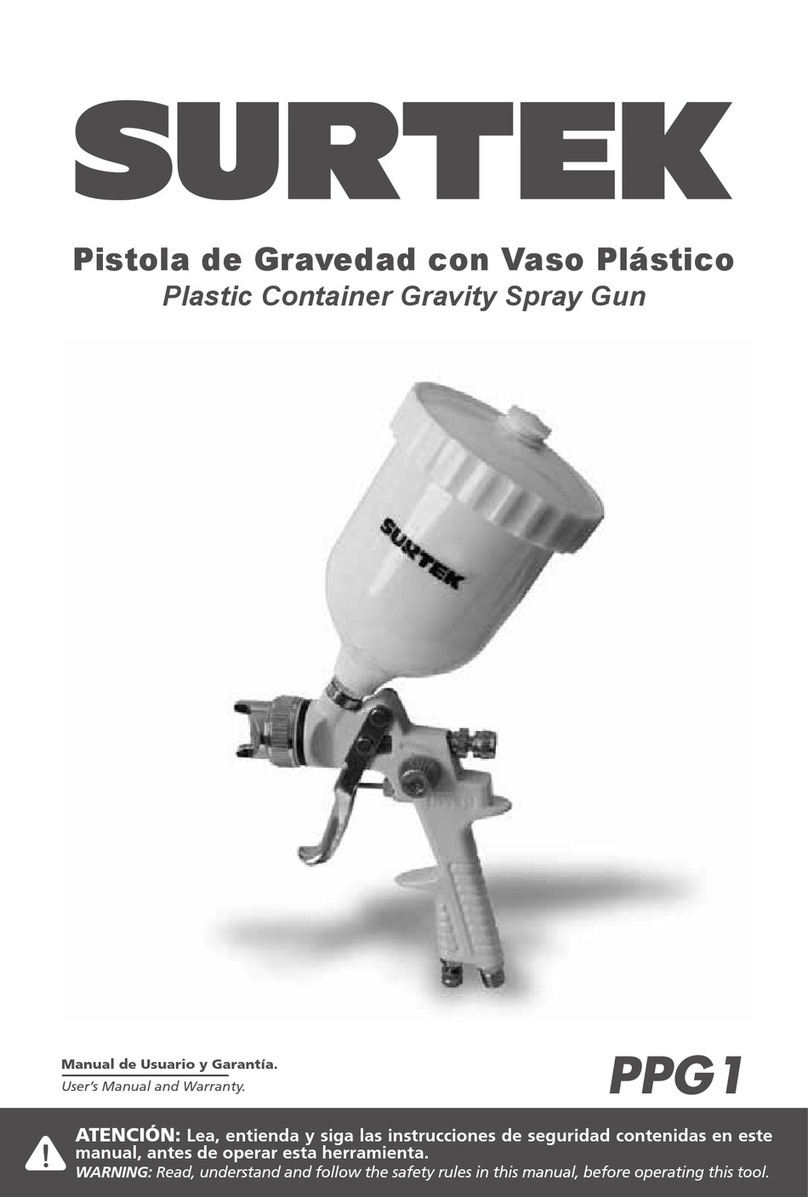
Surtek
Surtek PPG1 Dimensions and installation guide
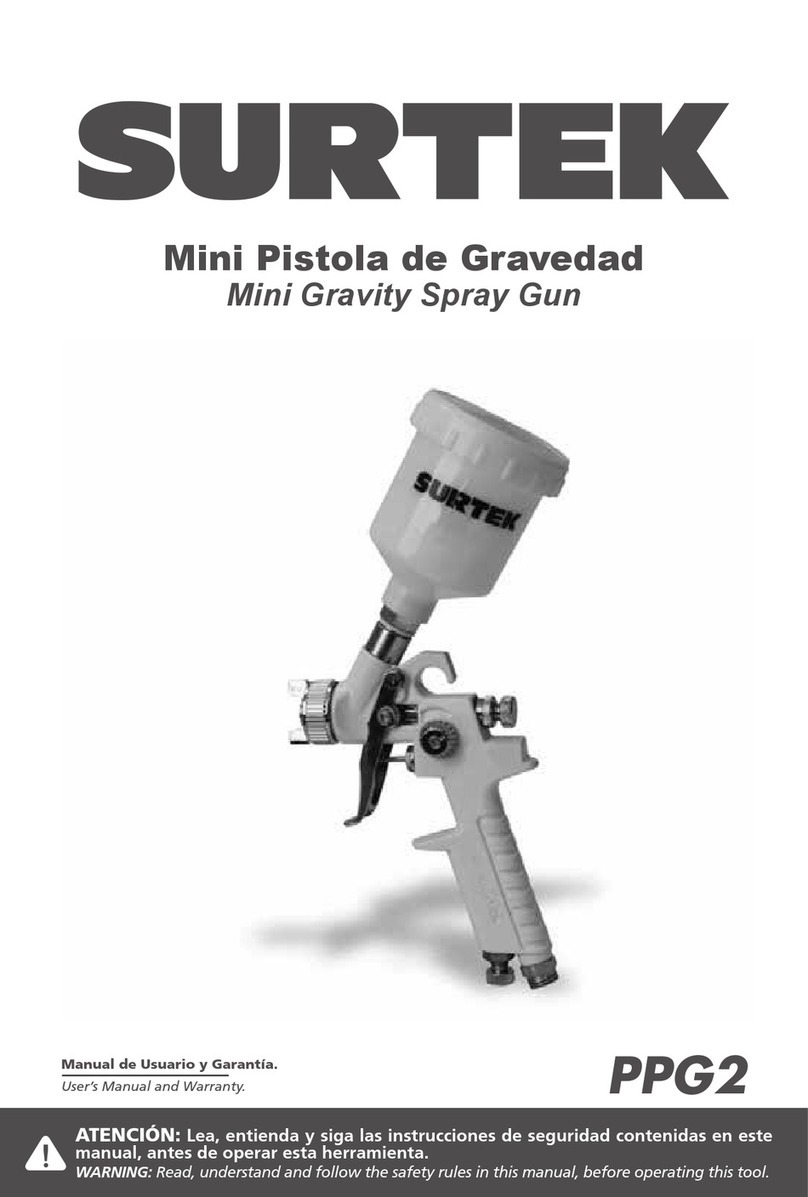
Surtek
Surtek PPG2 Dimensions and installation guide
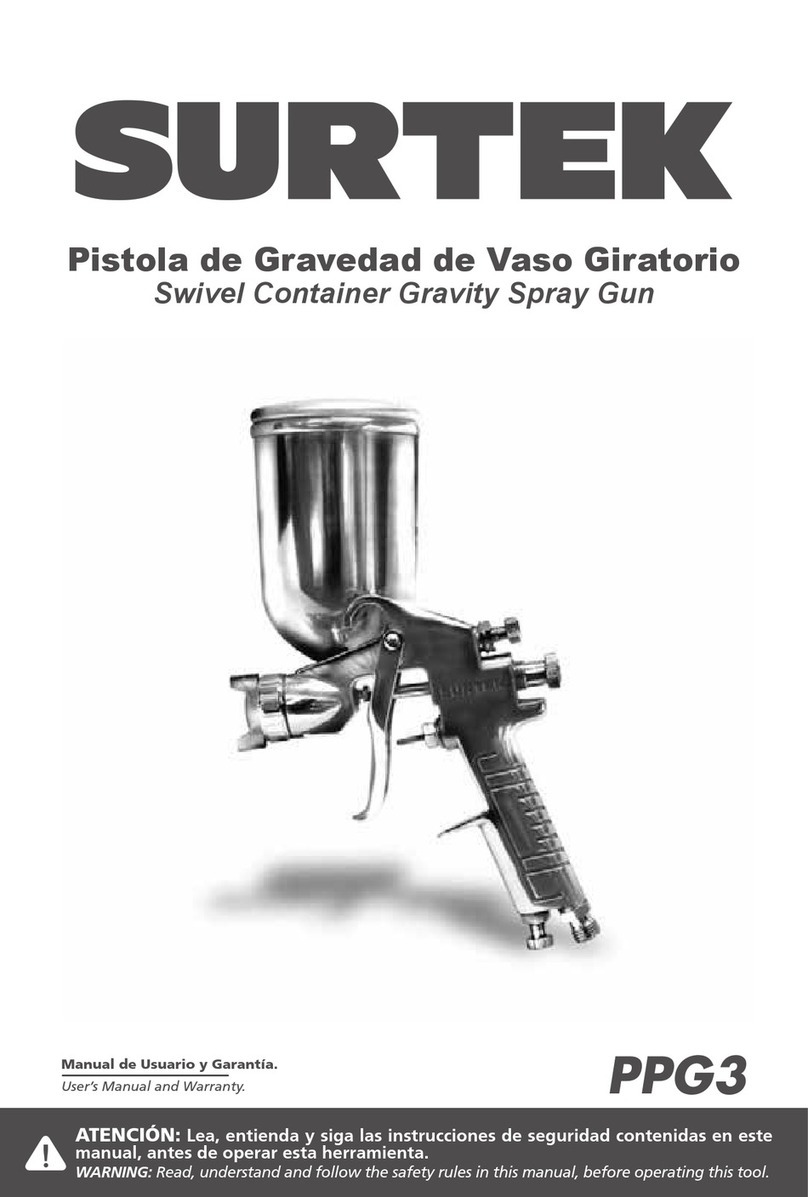
Surtek
Surtek PPG3 Dimensions and installation guide
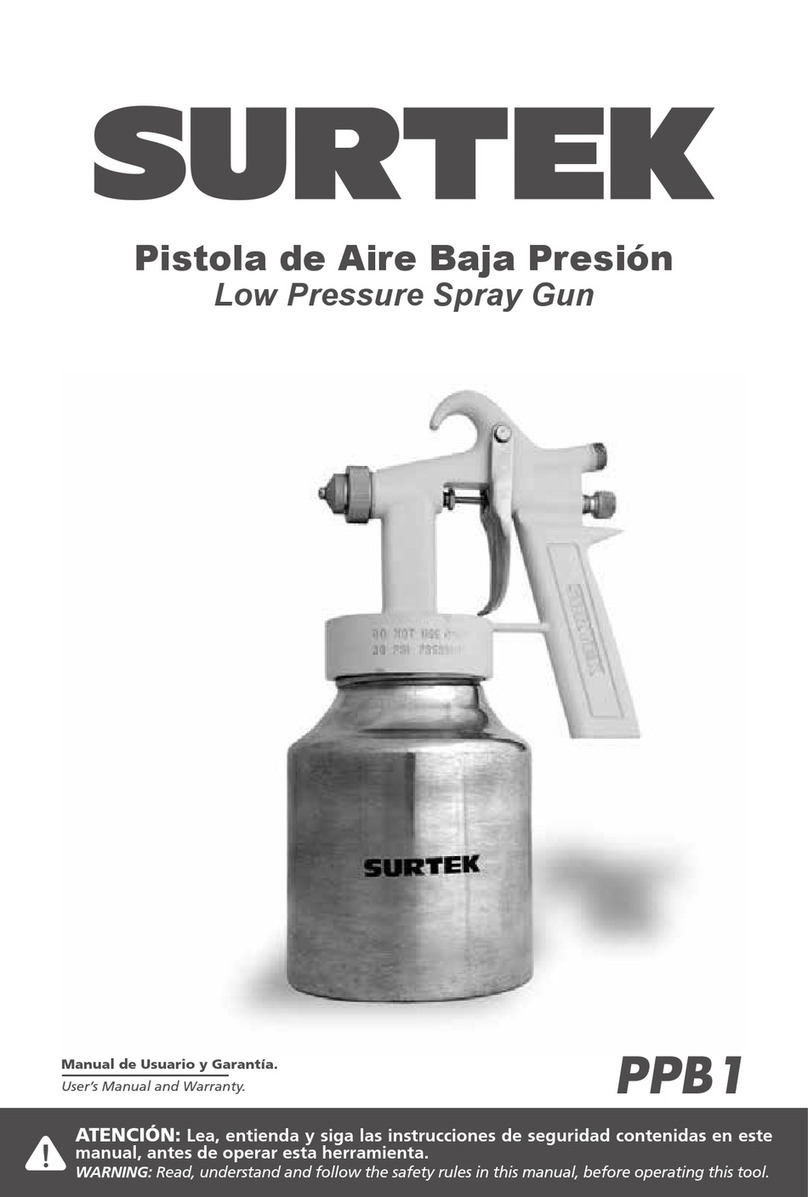
Surtek
Surtek PPB1 Dimensions and installation guide
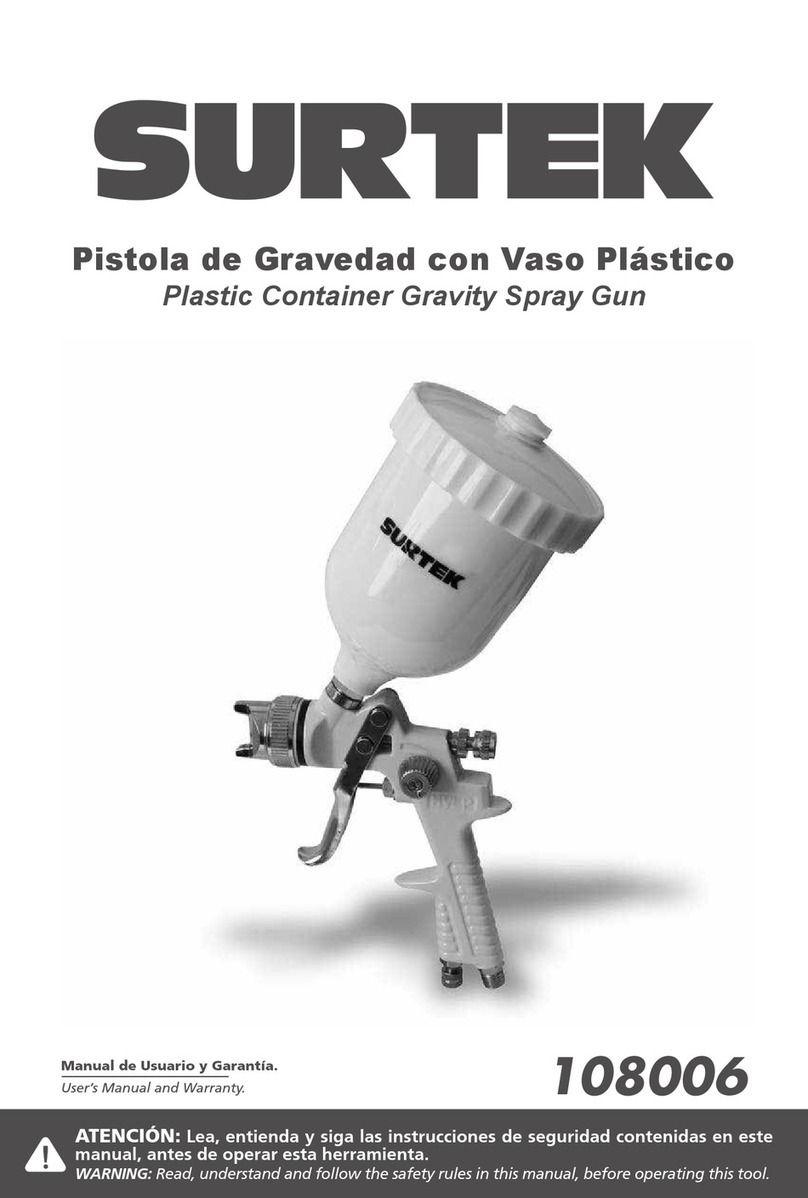
Surtek
Surtek 108006 Dimensions and installation guide
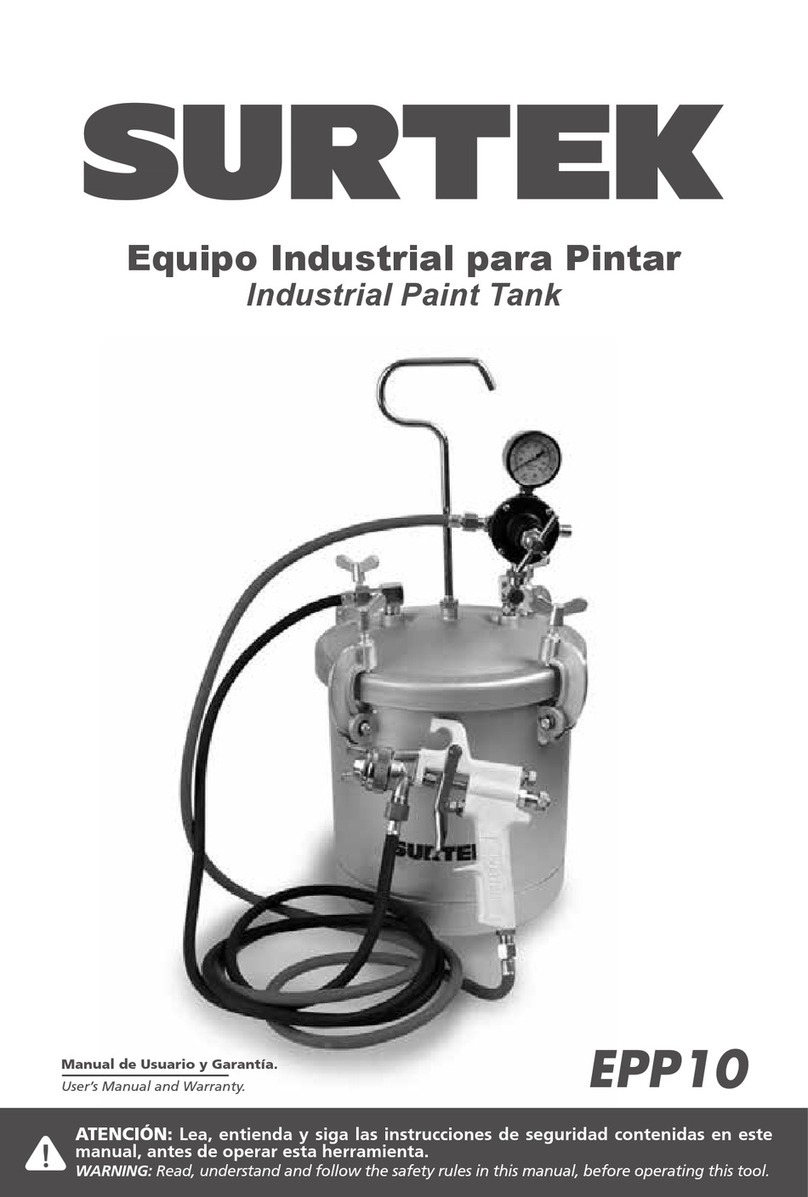
Surtek
Surtek EPP10 User manual
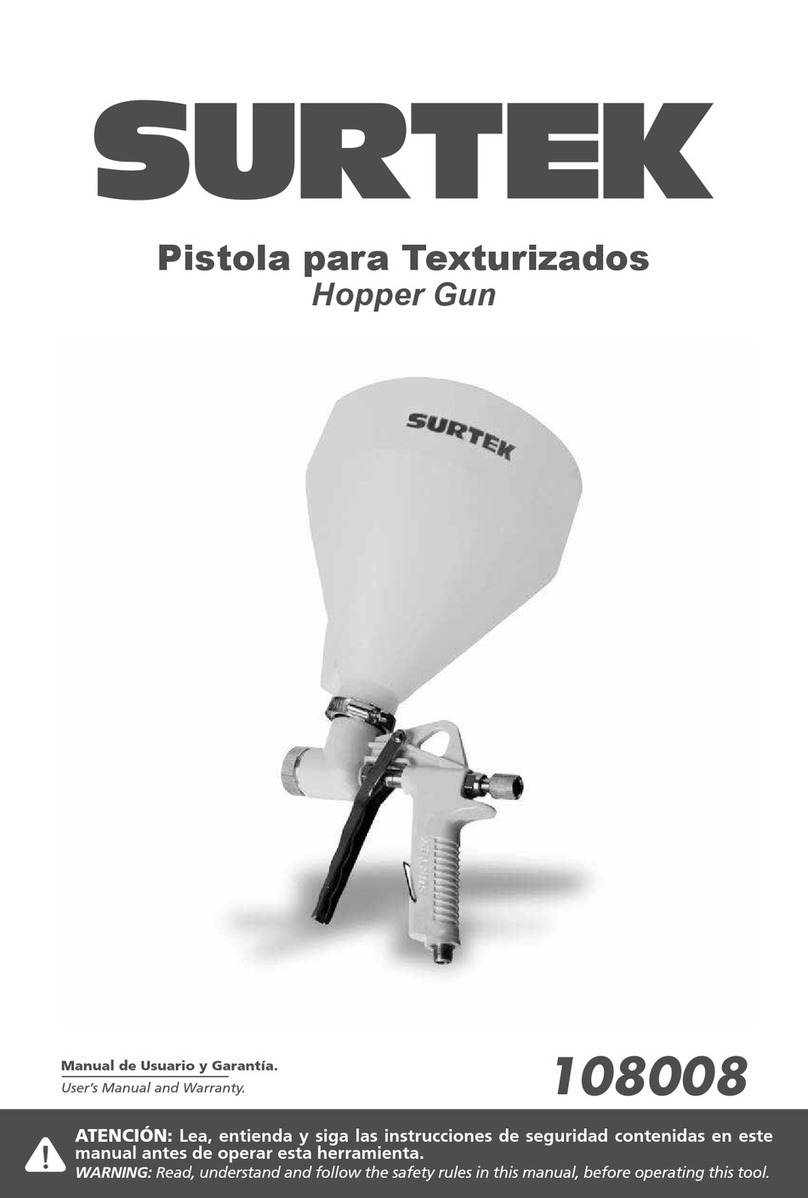
Surtek
Surtek 108008 User manual
